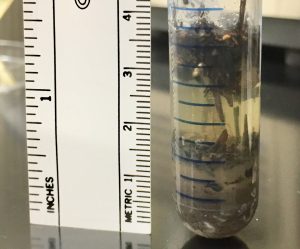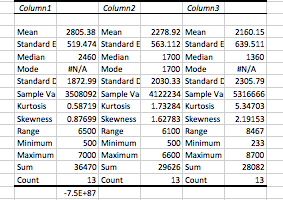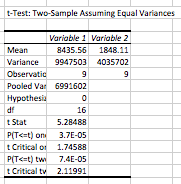The Ciliate Count Challenge
9/28/2017
Purpose: The purpose of this lab activity is to use the tetrahymena culture to determine the concentration of the sample in cells/mL. Practicing using micropipettes and performing serial dilutions was also a key part in this lab activity. Once the concentration was determined, the replicate, mean, and standard deviation is to be reported. After this, is finished the minimum amount of 1M solution of NaCl that will cause an immediate effect on Tetrahymena was determined. Tetrahymena behavior and survival were observed.
Procedure:
- Label 5 microcentrifuge tubes 0, -1, -2, -3, -4 and place them in a tube rack.
- Add a small amount of your sample to the tube marked 0- this is the undiluted sample.
- Add 90 microliters of diluent to each of the test tubes.
- Add 10 microliters of undiluted sample to the -1 tube and vortex briefly.
- Add 10 microliters of -1 sample to -2, vortex, and repeat for the rest of the tubes.
- Observe 5 microliters of each tube under a compound microscope and estimate the number of cells.
- Determine the average cell count in 5 microliters, average cell count per microliter, average cells per microliter in the undiluted sample, and the average cells per milliliter in the undiluted sample.
- Use the dilution with about 15-30 cells for your observations. Observe this dilution 3 times and calculate the mean cells per microliter.
- Using this same dilution, determine the minimum amount of 1M NaCl that the tetrahymena can withstand.
- Record all observations in the lab notebook.
- Clean up properly and return all samples and equipment to the proper place.
Observations
|
Dilution
|
Average cell count/ 5 microliter
|
Average cell count per microliter
|
Average cell count per microliter in undiluted sample
|
Average cells/mL in undiluted sample
|
|
0
|
37.5
|
7.5
|
57.5
|
7500
|
|
10^-1
|
25.66
|
5.13
|
51.33
|
51,333.33
|
|
10^-2
|
2.67
|
0.533
|
51.33
|
51,222.33
|
|
10^-3
|
2.33
|
0.467
|
467
|
467,000
|
|
10^-4
|
0
|
0
|
0
|
0
|
10^-1 average = 5.13 cells per microliter
This dilution was used for the 1M NaCl part of the lab.
5 microliters of Tetrahymena at 10^-1 dilution were tested with differing amounts of 1M NaCl. The following observations were made.
5 microliters = Immediately dead
3 microliters = Immediately dead
1.5 microliters = Immediately dead
0.75 microliters = Alive
Therefore, it was determined that the minimum amount of 1M NaCl that 5 microliters of Tetrahymena can withstand was 0.75 microliters.
Conclusion: This activity was very useful in furthering my micropipette and serial dilution skills. The information regarding the minimum amount of 1 M NaCl that tetrahymena was able to withstand is very useful in formulating our experiment. The next step in this lab is to use this information and go forward to see how an ammonium chloride solution will effect the tetrahymena culture.










